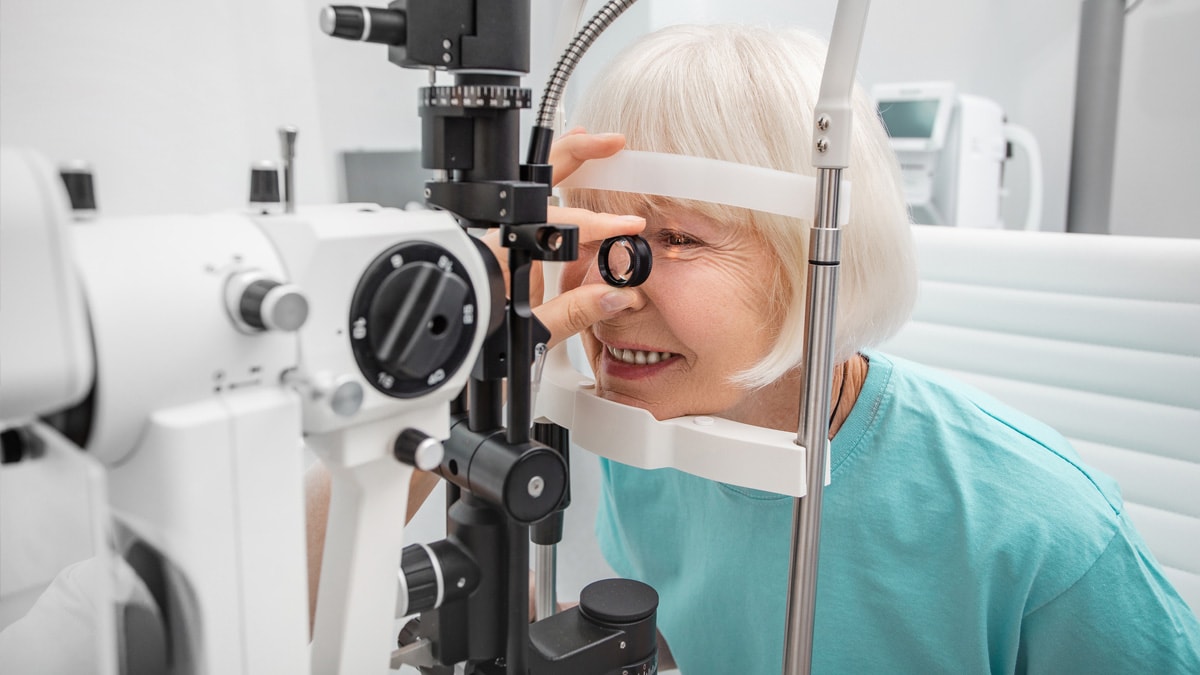Key points
- Glaucoma is a leading cause of irreversible blindness.
- Regular eye exams are needed for proper diagnosis and treatment.
- If found early, glaucoma can be treated and managed before vision loss or blindness occurs.

Glaucoma in the United States
Glaucoma is one of the leading causes of irreversible blindness in the United States.1 More than 3 million Americans have glaucoma.1 By 2050, that number is expected to rise to 6.3 million due to the aging US population.2 Glaucoma costs the US economy $2.86 billion every year in direct costs and productivity losses.
Currently, there is no cure for glaucoma. But if the disease is found early, it can be treated and managed before vision loss or blindness occurs. Because there are usually no symptoms, only 50% of people with glaucoma even know they have it.
Regular eye exams are needed for proper diagnosis and treatment. Certain population groups are at higher risk of becoming blind from glaucoma. These groups include Black or African American people, Hispanic or Latino people, people who are uninsured or underinsured, people living in poverty, and people living in rural areas with limited resources.3
Strategies that can help prevent eye disease among higher-risk groups include:
- Interventions that offer free or cost-effective vision screening.
- Educational programs.
- Outreach to help guide people to the resources they need.
Who is at higher risk for glaucoma?
Members of some racial and ethnic groups are at higher risk of developing glaucoma. For example:
- A 2016 study found that 81% of glaucoma cases among Hispanic or Latino people are undiagnosed and untreated compared to 73% in non-Hispanic White people.4 By the year 2050, it is expected that 50% of all glaucoma patients in the United States will be Hispanic people.4
- Glaucoma is six times more common among Black or African American people than White people.3
Other risk factors for glaucoma1 include:
- Being age 60 or older.
- Having a family history of glaucoma.
- Having diabetes or high blood pressure.
Improving glaucoma detection and care among high-risk populations
CDC supports glaucoma detection projects across the country through its Vision Health Initiative (VHI) Glaucoma Detection Program. These studies are designed to reach populations at high risk and overcome challenges to screening and treatment.
In 2019, VHI funded three cooperative agreements to help local groups reach specific populations in need. These 5-year SIGHT studies are working to improve glaucoma detection, referral, and sustained follow-up eye care through innovative outreach and service delivery models.
University of Alabama at Birmingham
The university's Department of Ophthalmology and Visual Sciences is assessing the effectiveness of a primary care-based glaucoma screening program in Federally Qualified Health Centers in rural Alabama.
Rural communities often have high rates of unemployment and poverty, large numbers of people without insurance, and limited health care services and community resources.
Program activities include:
- Using a portable device to conduct optic nerve structure assessments. This approach can more efficiently reach people living in rural areas with limited transportation and resources.
- Identifying and evaluating ways to remove barriers that prevent patients from receiving follow-up care.
- Comparing the cost effectiveness of this program to standard care with a specialist.
The goal of this study is to develop a program that can be expanded nationwide into both rural and urban communities to reach populations at high risk for glaucoma.
University of Michigan
The university's Department of Ophthalmology and Visual Sciences is using innovative community-based strategies to identify barriers to preventing vision loss in population groups at high risk for glaucoma. These groups include people who are members of certain racial and ethnic minority groups, people who live in poverty, and people who are uninsured or underinsured.
Program activities include:
- Using a validated telemedicine approach to screen for glaucoma and other eye diseases among populations at high risk in community primary care clinics.
- Using personalized counseling and education programs through an electronic platform to improve glaucoma follow-up care.
- Conducting a cost-benefit analysis of the program.
The goal of this study is to evaluate the program to see if it can be effective in other communities.
Columbia University
The university's Department of Ophthalmology is working to identify innovative strategies to reach members of certain racial and ethnic minority groups at high risk of vision impairment or glaucoma and other eye diseases but who are not getting the eye care services they need.
Program activities include:
- Developing and implementing a community vision screening and follow-up intervention in people living in affordable housing.
- Evaluating the effectiveness of using patient navigators to help patients get recommended follow-up eye care after vision screening.
- Conducting an economic analysis to examine the cost effectiveness of the program.
The goal of this study is to share program findings and create a model that other communities can use to provide similar services to prevent vision loss from glaucoma and other eye diseases.
For more information, visit sightstudies.org.
- BrightFocusFoundation. Glaucoma: Facts and Figures website. Accessed November 19, 2019. https://www.brightfocus.org/glaucoma/article/glaucoma-facts-figures
- National Eye Institute. Glaucoma Data and Statistics website. Accessed November 19, 2019. https://www.nei.nih.gov/learn-about-eye-health/resources-for-health-educators/eye-health-data-and-statistics/glaucoma-data-and-statistics
- Allison K. Racial disparity in the prevalence of glaucoma in the United States. Eye Reports. 2019;5:1. Accessed December 31, 2019. https://www.eyereports.org/index.php/eyereports/article/view/73
- Niraj N, Joos K. Glaucoma disparities in the Hispanic population. Semin Ophthalmol. 2016;31(4):394–399.
